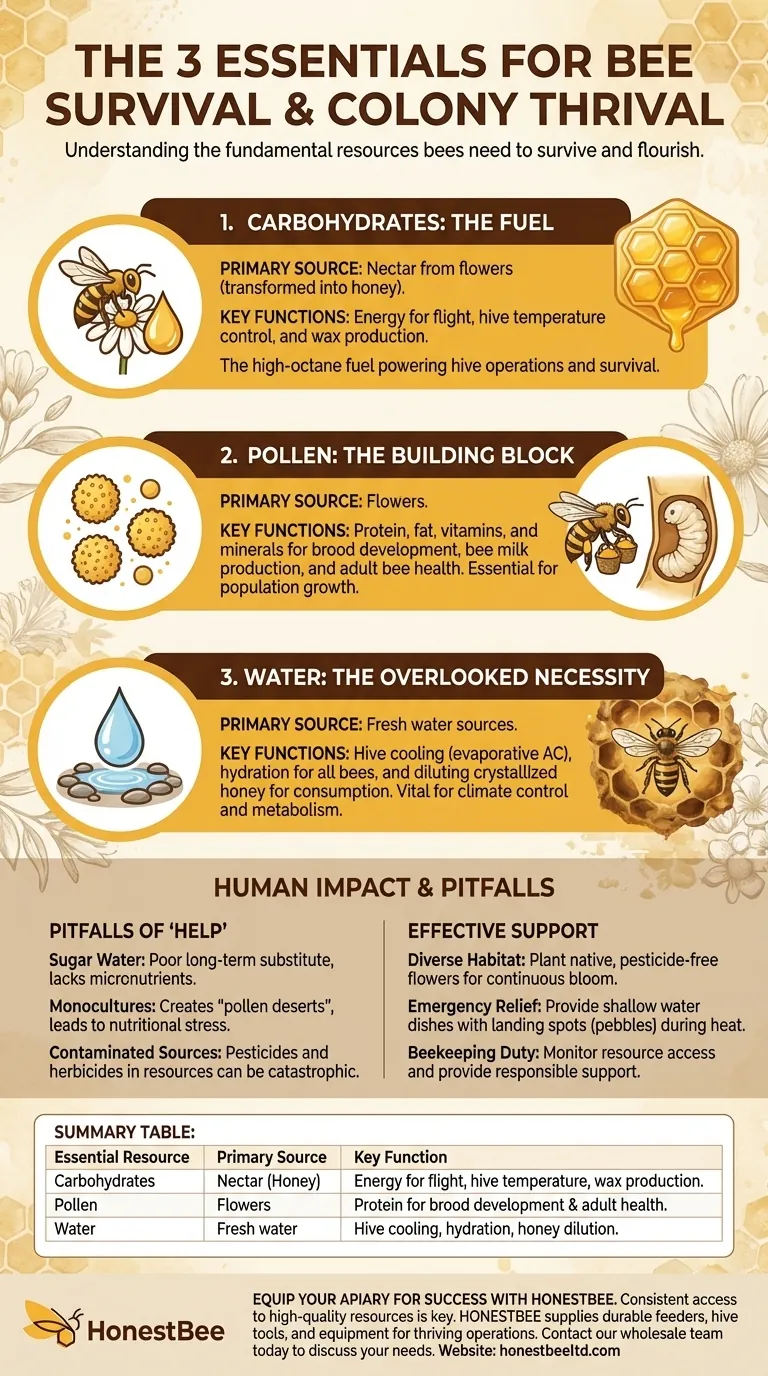To thrive, every bee colony relies on three fundamental resources. While we often think of them simply needing flowers, their requirements are more specific. For a hive to survive and flourish, it needs a constant and reliable supply of water, carbohydrates for energy, and protein-rich pollen for growth.
A bee's relationship with a flower is a transaction. They are not just visiting for "food" in general, but are strategically collecting two distinct resources—carbohydrates from nectar and protein from pollen—while also needing a separate source for water.

Carbohydrates: The Fuel for the Colony
Carbohydrates are the high-octane fuel that powers every activity in the hive. For bees, this primarily comes from the sugar-rich nectar they collect from flowers.
The Role of Energy
Nectar provides the immediate energy required for flight, foraging, and maintaining the hive's internal temperature. Within the hive, bees transform nectar into honey, a stable and dense energy store for winter or periods of scarcity.
Powering Hive Operations
This energy also fuels critical internal functions, including the production of beeswax. Worker bees consume large amounts of honey to power the glands that secrete the wax used to build and repair the honeycomb.
Pollen: The Building Block of Life
If nectar is the fuel, pollen is the essential protein, fat, vitamin, and mineral source that builds and maintains the bees themselves. It is the solid food that enables growth and development.
Fueling the Next Generation
Pollen is absolutely critical for raising brood. Nurse bees consume pollen to activate glands that produce "bee milk," a special secretion used to feed larvae. Without sufficient pollen, a colony cannot raise new bees, and its population will collapse.
Sustaining Adult Health
Pollen is not just for the young. It provides the protein necessary for the development and health of all adult bees, ensuring they are strong enough to perform their duties as foragers, guards, or caretakers.
Water: The Overlooked Necessity
Water is a vital resource that is often forgotten but serves multiple, critical functions for the colony's survival. Bees will actively forage for it just as they do for nectar and pollen.
The Hive's Air Conditioning
On hot days, bees spread thin films of water inside the hive and fan their wings. This creates evaporative cooling, acting as a natural air conditioning system to protect the developing brood and prevent the wax comb from melting.
Hydration and Food Preparation
Like all living creatures, bees need water for their own metabolic processes and hydration. They also use it to dilute thick, crystallized honey into a liquid consistency that can be consumed by both adult bees and larvae.
Understanding the Pitfalls of Human "Help"
While well-intentioned, human intervention can sometimes create problems if it doesn't align with the bees' actual needs.
The Problem with Sugar Water
Providing sugar water can be a lifesaver for a struggling colony during a nectar shortage. However, it is a poor long-term substitute for nectar, as it lacks the complex micronutrients, enzymes, and unique floral compounds found in natural sources.
Monocultures and Nutritional Stress
Large-scale agriculture that focuses on a single crop (monoculture) can create a "pollen desert." While bees may have access to abundant nectar for a short period, the lack of diverse pollen sources leads to nutritional deficiencies, weakening the colony's collective immune system.
Contaminated Sources
Pesticides and herbicides can contaminate all three essential resources. Nectar and pollen from treated plants, as well as water from contaminated puddles or runoff, can be catastrophic for a hive, causing direct mortality or sublethal effects that impair navigation and health.
How to Effectively Support Bees
Understanding these three pillars allows you to provide support that truly makes a difference.
- If your primary focus is providing a complete habitat: Plant a diverse range of native, pesticide-free flowers that bloom from spring through fall and provide a shallow water source with landing spots like pebbles or marbles.
- If your primary focus is providing emergency relief: A simple, shallow dish of water with safe landing spots can be a lifesaver for thirsty bees during extreme heat or dry spells.
- If you are considering beekeeping: Recognize that your central duty will be monitoring the hive's access to these three resources and providing responsible support when natural sources are scarce.
By understanding what bees truly need to survive, you move beyond simple appreciation and become a genuine ally in their preservation.
Summary Table:
| Essential Resource | Primary Source | Key Function |
|---|---|---|
| Carbohydrates | Nectar (Honey) | Energy for flight, hive temperature control, and wax production. |
| Pollen | Flowers | Protein for brood development and adult bee health. |
| Water | Fresh water sources | Hive cooling, hydration, and honey dilution. |
Equip your apiary for success with HONESTBEE. Whether you're a commercial beekeeper or a distributor, ensuring your hives have consistent access to high-quality resources is key to colony health and honey production. HONESTBEE supplies durable beekeeping supplies and equipment designed to support thriving operations. From feeders to hive tools, we provide the reliable gear you need. Contact our wholesale team today to discuss your needs and strengthen your beekeeping business.
Visual Guide

Related Products
- Premium Traditional Copper Bee Smoker with Bellows
- Wooden Queen Bee Excluder for Beekeeping
- Slatted Porter Style Bee Escape for Rapid Hive Clearing
- Economy Small Scale Honey Dryer Dehumidifier Thickening Machine
- Brown Nicot Queen Cell Cups for Breeding Queen Bees Beekeeping
People Also Ask
- How did early beekeepers use bee smokers? Master Ancient Bee Calming Techniques
- What happens to bees when they sense smoke? Unlock the Secret to Calm Hive Inspections
- How does water mist work as an alternative to smoke in beehives? A Guide to Safe & Effective Use
- What are the main components of a bee smoker? A Guide to Safe and Effective Hive Management
- What is the primary purpose of using smoke in beekeeping? Calm Bees for Safer Hive Management



















